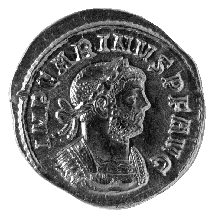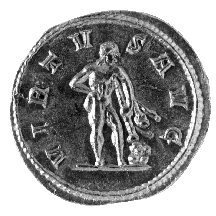



(123) Carinus - AV aureus, A.D. 284, 4.52 g. (inv. 91.233).
Obverse: Laureate and cuirassed bust of Carinus r.; IMP(ERATOR) CARINVS
P(IVS) F(ELIX) AVG(VSTVS): Imperator Carinus, pious, fortunate Augustus.
Reverse: Nude Hercules standing r., leaning on club; VIRTVS AVG(VSTI): Virtus
of the Augustus.
Provenance: Abner Kreisberg, 1960.
Bibliography: P.H. Webb, The Roman Imperial Coinage V.2 (London 1933)
233.
Marcus Aurelius Carinus, son of the emperor Carus, was made Caesar shortly
after his father's accession in A.D. 282, at about the age of thirty-three.
He was put in charge of the troops in the West while his father went to
the East on a campaign against the Persians. In A.D. 283 he and his brother,
Numerian, were elevated to the rank of Augustus, and shortly afterward their
father was killed, reportedly struck by lightning. When Numerian was murdered
on the way back from Persia in A.D. 284, Carinus became sole emperor. Meanwhile,
Diocletian had been proclaimed emperor by his troops, and he marched against
Carinus. They met in a battle at Margus in Moesia, which was won by Carinus,
but he was murdered on the battlefield by one of his men whose wife he had
seduced.
The portrait of Carinus on the obverse of this aureus reverts to the standard
military type of the third-century emperors, with very short hair and beard,
but like the portraits of Postumus (see no. 121) and Probus (see no. 122),
it also depicts an elaborate cuirass. The reverse, celebrating the Virtus
of the emperor, depicts Hercules with his most common attributes, the club
and lionskin. These refer to one of his twelve labors, in which he killed
the lion that the goddess Juno had sent to destroy him.
C.L.L.



All contents copyright (c) 1996.
Lawrence University
All rights reserved.